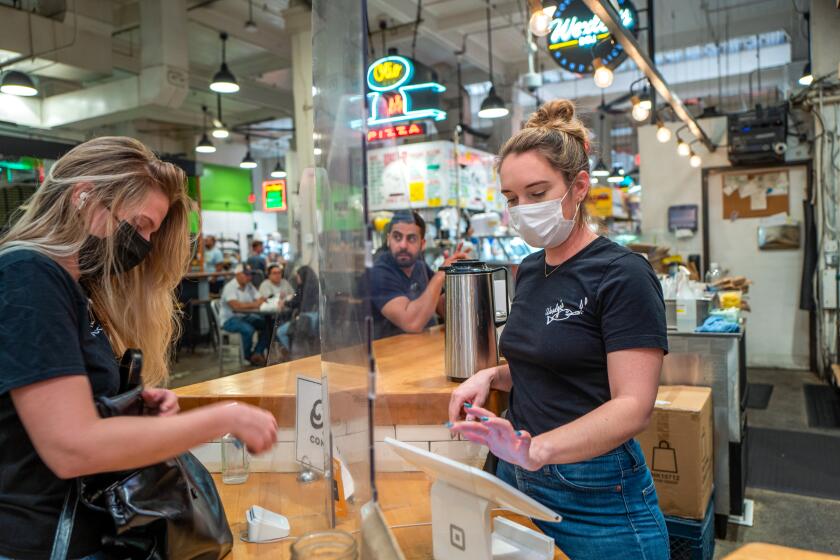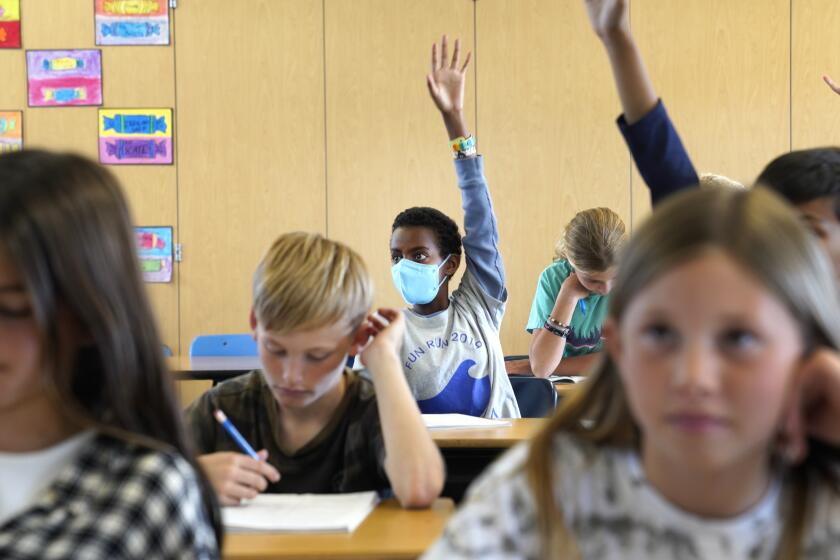As California coronavirus hospitalizations rise, Bay Area divided on mask rules

San Francisco and the greater Bay Area were pioneers in imposing the nation’s first regional stay-at-home order in early 2020 when the coronavirus first hit. And the region takes pride in the relatively low cumulative death rate throughout the pandemic.
But with coronavirus-positive hospitalizations rising and some residents worried about the high rate of viral transmission, San Francisco is facing some scrutiny for its decision to not go back to indoor mask mandates.
Across the bay from San Francisco, officials in Alameda County — which is home to Oakland — issued a new indoor mask mandate last week. And Los Angeles County has outlined criteria that would trigger the same, with officials saying it’s plausible that could happen by early July if current trends hold.
But San Francisco and the rest of the Bay Area have thus far held off on reinstating a mask mandate, saying they don’t see the need for it.
That has caused consternation among some San Francisco residents, who have begun to regularly voice anger at meetings of the city’s health commission, urging them to reimplement a universal indoor mask order, or at least order one for the city’s Muni public transportation system.
According to a Times analysis of state data released Tuesday, Santa Clara and San Francisco counties had the worst coronavirus case rates in California: 401 and 400 coronavirus cases a week, respectively, for every 100,000 residents. A rate of 100 and above is considered a high degree of transmission.
But San Francisco health officer Dr. Susan Philip said Tuesday the city has some of the highest vaccination rates in the nation, high-quality masks and anti-COVID drugs are plentiful, and hospitals have the capacity to accept patients.
Some public health officials are not convinced the state’s dip in coronavirus cases will stay consistent in the coming weeks.
In San Francisco, 84% of residents have completed their primary vaccination series; in Santa Clara County, it’s 86%; and in Alameda County, it’s 83%. By contrast, L.A. County’s vaccination rate is 72%; the national vaccination rate is 67%.
Philip credited San Francisco’s previous tough approach on health orders with saving lives. “It has contributed to having San Francisco really be able to be proud of having the lowest death rate of any large city and any large county in the United States,” she said at Tuesday’s health commission meeting.
But this phase of the pandemic is different.
“Cases are high — they are still high — although they are lower than during the Omicron surge of BA.1 this winter. And severe disease resulting in hospitalizations is not as high as during the winter surge, fortunately,” Philip said. “We now have readily available high-quality masks like N95s, KN95s and KF94s. Most importantly, we have among the highest rates of vaccination in the world in our city.”
San Francisco health director Dr. Grant Colfax added that the city’s “hospital capacity remains adequate to care for people with COVID.”
Still, a mask order might be needed again in the future if there’s a new variant that causes severe illness that can’t be prevented by existing vaccinations or treated by drugs, Philip said.
“I hope that does not happen. But if it does, we will need to go back to generalized orders, including masking mandates, and they will have to be strictly enforced,” Philip said. “It is my feeling that we should wait and really use something like a health order when we get to that point.”
Officials are deciding how best to respond now that COVID-19 cases are rapidly rising after plunging in the spring.
Some residents expressed dismay at Philip’s decision.
Elissa Matross, 75, speaking to health commissioners, said the lack of a mask mandate on the city’s Muni bus and rail system has forced her to abandon Muni and take Bay Area Rapid Transit instead. BART does have a mask order on its commuter rail system but goes to fewer places.
“As a newly retired San Francisco Unified School District teacher, I envisioned a life that even with COVID, I would be able to ride Muni to doctor’s appointments, parks and museums,” she told commissioners. “I have underlying health issues, which makes the risk of contracting COVID and long COVID terrifying. I have a medically fragile husband with limited mobility, and two 1-year-old grandchildren who are too young for vaccines. I must keep them safe.”
The Santa Clara County public health director and health officer, Dr. Sara Cody, said at a news conference in May that she did not intend to reorder a mask mandate for the Bay Area’s most populous county.
“At this point, we don’t have any plans to do anything apart from being aligned with the state with regards to a mask requirement,” Cody said at the time. “The state still strongly recommends masking indoors, and we still strongly recommend masking indoors.”
While an increase in new weekly coronavirus-positive patients in hospitals is one of the criteria that would trigger mask recommendations from the U.S. Centers for Disease Control and Prevention, Cody told the Santa Clara County Board of Supervisors on Tuesday that the most significant effect hospitals are reporting from the current wave is workers being out sick with COVID-19.
“What we’re not seeing so far with this wave is a lot of people who are getting seriously ill and requiring hospitalization for their COVID infection. Of course, we’re seeing some of that, but not in the dramatic way that we’ve seen in other waves,” Cody said.
By contrast, the health officer of Alameda County, east of San Francisco and north of Santa Clara County, last week reimplemented a mask order. The new requirement for the Bay Area’s second most populous county does not apply to Berkeley, which has a separate public health department.
“Rising COVID cases in Alameda County are now leading to more people being hospitalized,” Alameda County health officer Dr. Nicholas Moss said in a statement. “We cannot ignore the data, and we can’t predict when this wave may end. Putting our masks back on gives us the best opportunity to limit the impact of a prolonged wave on our communities.”
Some applauded Moss’ move.
“These decisions are not taken lightly. I appreciate the courageous leadership displayed by Alameda County’s health officer and hope it will be enough to slow spread,” tweeted Dr. Noha Aboelata, a family physician and chief executive of Roots Community Health Center in Oakland.
There are some exemptions in Alameda County’s latest order, such as allowing people at the gym “actively engaged in periods of heavy exertion” to be maskless.
The coronavirus has been spreading rapidly across California, setting up an anxious summer that could include the return of mask mandates.
At a campus briefing last week, Dr. George Rutherford, a UC San Francisco epidemiologist and infectious-disease expert, was asked by a colleague why he thought San Francisco wasn’t imposing a mask mandate.
“These are really kind of very close calls,” Rutherford said.
Elected officials have had differing thoughts about mask mandates. In February, one member of the Santa Clara County Board of Supervisors, Cindy Chavez, criticized a decision to retain a local mask order longer than required by the state.
In Alameda County, by contrast, county Supervisor Keith Carson said in mid-February he thought the local mask mandate should have continued for a longer period of time. Moss in February agreed to lift the indoor mask mandate as soon as the state allowed counties to do so.
In Los Angeles County, Public Health Director Barbara Ferrer has consistently said that if the county is designated as having a high COVID-19 community level as defined by the CDC, officials will reinstate a universal mask mandate in indoor settings for those 2 and older.
Once a county enters a high COVID-19 community level, the CDC recommends universal masking in indoor public settings.
Ferrer last week said she applauded Alameda County’s decision to reinstate a mask mandate. She also has expressed support for other institutions, such as UCLA, in implementing mask orders, saying local leaders are looking at community data to make decisions to provide “maximum protection, particularly for those people most vulnerable.”
L.A. County has already imposed a local mask order in public transportation settings, such as on buses, trains, app-hailed rides, subway stations and in airport terminals.
Compared with the San Francisco Bay Area, Los Angeles County is structurally more vulnerable to the worst effects of the coronavirus, according to research, in part due to relatively higher levels of poverty and large swaths of communities where there’s overcrowding.
L.A. County’s cumulative COVID-19 death rate is significantly higher than that of the Bay Area.
“There is an impressive body of reputable research at this point that shows how masks reduce the risk for individuals and slow viral transmission in the community,” Ferrer said.
More to Read
Start your day right
Sign up for Essential California for news, features and recommendations from the L.A. Times and beyond in your inbox six days a week.
You may occasionally receive promotional content from the Los Angeles Times.










